Summary:
"Dog bloat (GDV, food bloat or gastric dilation-volvulus) refers to a condition where a dog's stomach bloats and can twist. A normal stomach should be contracting and releasing food. A dog with bloat takes in excess air or food, causing the stomach to be distended. It cuts off the blood supply and keeps the food and air from exiting.
It is a life threatening disorder with fatalities
ranging
from 10% to 60%. The disease primarily occurs in large deep-chested
dogs between the age of 2 to 10 years. No one knows what causes the
condition. It frequently occurs several hours after a large
evening meal with symptoms occurring around midnight.
Signs of GDV (dog bloat) are:
- abdominal pain
- distension
- weakness
- collapse
- depression
- nausea
- salivation
- increased heart-rate
- vomiting
- retching
- blue color to tongue or gums
Risk factors for bloat include being a large breed dog (highest percentage of dogs) that is deep chested such as a Great Dane (long length chest with small width). Other risk factors are age (over age 7), rigorous exercising after eating or eating too quickly. It is a myth that an elevated dog food bowl will decrease the risk of developing GDV (2015, Cornell Veterinary). In fact, the risk increases with an elevated bowl. Food bloat refers to bloat without the stomach twist. The twist is referred to as volvulus.
The exact reasons why dogs suffer from bloat are not understood and not
all cases are associated with the identified risk factors.
Always contact a veterinarian if you aren't sure or if there is any
chance
that your dog is suffering from bloat (see second video on page for dog
suffering from bloat symptoms). Veterinarians will work to
remove any air or food from the stomach. Surgery is needed if the
stomach moves out of its' normal position, such as a twist or
volvulus. Prevention includes having a dog eat slowly and rest
after eating a meal (1 to 2 hours).
Overview
Bloat (gastric dilatation volvulus) is a very serious condition that requires immediate care. It is the condition showcased in the movie Marley and Me. Approximately 50% of dogs with the condition do not survive. Dog bloat is usually seen in middle aged and older dogs. The exact cause of the condition is not completely understood although contributing factors can include (but not always):
- Ingesting large amounts of water and food
- Delayed emptying of the gastric system
- Too much activity after eating
There is no direct genetic predisposition. Risk factors include:
- Dogs that have a first-order relative that had bloat
- Large
breeds dogs, with an incidence in this population of
6%
- Dogs over 100 pounds have a 20% higher risk
- The condition can happen at any age, although middle aged and older dogs have a higher risk.
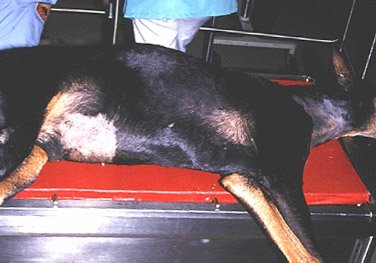
Breeds at higher risk include:
- Great Danes (highest risk)
- Saint Bernard
- Weimaraner
- Irish Setters
- Gordon Setters
- Standard Poodle
- Bassett Hounds
- Doberman Pinschers
- Old English Sheepdog
- German Shorthaired Pointer
- Newfoundland
- German Shepherds
- Airedale Terrier
- Alaskan Malamute
- Chesapeake Bay Retriever
- Boxer
- Collie
- Labrador Retriever
- English Springer Spaniel
- Samoyed
Breeds that are at risk, but not as much as above include:
- Dachshunds
- Pekingese
- Sharpei
- Rottweilers
New research (2015) shows that IT IS NOT TRUE that a lowered food bowl can lead to the swallowing of air (aerophagia) which could lead to GDV. Abnormal tumor or cell growth may also lead to GDV. More research needs to be conducted.
With bloat, the stomach fills with fluid. Gas and fluid continue to
build before the stomach rotates. As the stomach enlarges (becomes
distended), pressure increases in the abdomen leading to compressed
blood vessels in the abdomen. The reduced blood flow can put the dog
into hypovolemic shock.
The disease can be characterized in three stages of dog bloat. The
goal of course is to stop the disease before it proceeds to stages II
and III.
- Pre-bloat: Stomach function is normal, but gas accumulates in the
stomach and it is not emptying as it should.
- 'Stage 1: Stomach starts to dilate
- Stage 2: Blood supply to part of the stomach is cut off and stomach tissue is damaged
- Stage 3: Spleen and stomach tissue become necrotic (start to die
off). Heart failure and shock set in and is irreversible. Can
result in death.
Your emergency veterinary center will drain the stomach and then attempt to reposition the organs. Half of dogs with bloat do not survive making early diagnosis and treatment is critical.
Bloat is actually made up with two conditions. The first, called gastric dilation refers to the stomach filling with food, fluid and gas or air. The second part of the condition is called volvulus, which refers to a stomach that rotates. The twisting can range from 180 to 360 degrees in a clockwise direction. The stomach twist causes part of the stomach, the pylorus to move out of position. This prevents air and fluid from leaving the stomach, through what is called pylorus canal.
The twisting prevents fluids from leaving your dogs body, not just stomach fluids, but the ability to vomit as well. The condition cuts off blood flow to the stomach tat causes cells to start dying. Since the stomach cannot drain, it becomes distended, interfering with circulation in the stomach and the death of cells in the wall of the stomach (called necrosis).
As the stomach starts to fill or become distended, pressure increases. This compresses the abdominal blood vessels such as the portal vein and caudal vena cava. The lack of blood flow results in less blood going to the heart and a condition call hypovolemic shock, where there is less blood circulating in the body. Shock can occur from the low blood pressure and endotoxins that rapidly develop. If the stomach ruptures, a condition call peritonitis can occur, which is an inflammation of the membrane that lines the wall of the abdomen and covers the abdominal organs.
This in turn causes problems throughout the body such as organ death, inflammation and blood clotting (coagulation).
Symptoms of Bloat in Dogs
Bloat symptoms include:
- Salivation (Ptyalism)
- Retching
- Attempts to vomit that are not successful
- Pacing
- Restlessness
- Whining
- Groaning
- Lethargy
- Acting uncomfortable
- Walking with stiff legs
- Head hanging
- Anxious behavior
- Abdominal pain
- Abdominal distension (may be hidden by the rib cage)
- Excessive salivation
- Depression
- Vomiting
Late symptoms of dog bloat include:
- Pale tongue
- Pale gums
- Rapid heart rate
- Labored and rapid breathing
- Weakness
- Collapse
Several body systems are affected by bloat including the:
- gastrointestinal (stomach necrosis or cell death due to decreased blood supply)
- cardiovascular (decrease in blood return to the heart causing organ problems and tissue damage)
- lymphatic system problems.
Diagnosis
X-Rays are used to diagnosis the condition. A veterinarian will look for a distended abdomen. It is possible that a distended stomach can be hidden by the rib cage.
Other signs include fast heart rate (tachycardia), rapid breathing (tachypnea), labored breathing (dyspnea), weak pulse, and pale mucus membranes.
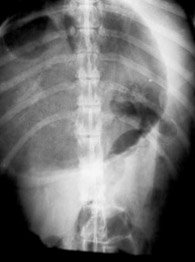 X-Ray of GDV or Dog Bloat
X-Ray of GDV or Dog BloatThe veterinarian will also seek to eliminate other possible causes such as:
- Septic peritonitis: inflammation of the membrane that lines the inside of the abdomen. It is often caused by a bacterial infection.
- Intestinal twisting (intestinal volvulus)
- Sudden gastroenteritis: irritated digestive tract, otherwise known as a stomach flu
Tests include blood and urine. X-rays are used to examine the abdomen. In some patients spleen torsion (twisting) is also diagnosed.
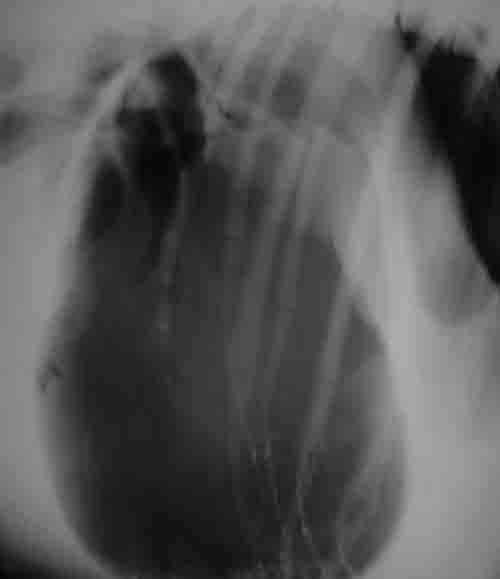 Dog Bloat X Ray
Dog Bloat X RayTreatment
Treatment is considered an emergency with hospitalization required.
If the dog is suffering from dilation of the stomach (gastric dilation)
then a tube is passed through the mouth to empty the stomach
(orogastric intubation). The stomach is washed out. The patient cannot
drink or eat for 36 hours followed by intravenous fluids. Once symptoms
subside, then the dog is allowed to resume a normal diet. In extreme
cases an owner may do it themselves using a tube coated with K-Y jelly."
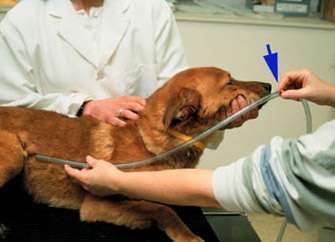 Dog Tube Measurement for Intubation
Dog Tube Measurement for IntubationIf a tube cannot be placed through the mouth, a transabdominal needle (percutaneous gastrocenteis) can be attempted. The veterinarian will use a catheter or large needle.
Antibiotics will be used in cases where an infection has taken hold. In dogs that triggered a heart problem, an anti-arrhythmic may also be required.
Dog Gastric Lavage
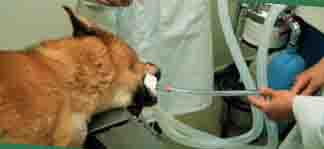 Dogs are sedated before inserting the
tube that will be used to empty the stomach. Fluids are drained with
gravity or with a syringe or suction pump.
Dogs are sedated before inserting the
tube that will be used to empty the stomach. Fluids are drained with
gravity or with a syringe or suction pump.Photo Credit: Washington University
Surgery is used if the stomach has twisted and all of the organs need to be placed back into their normal position. Surgery is used to correct stomach twisting (volvulus). The surgeon will reposition the spleen and stomach. Partial removal may be required if some cell death has occurred. Suturing the stomach wall to toe abdomen can help to prevent future problems (called a gastropexy). Antibiotics are used to prevent infection associated with surgery.
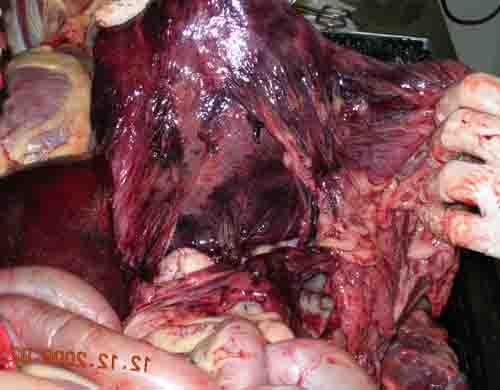
Patients need to be monitored for lack of blood flow to the cardiovascular system. Fluid therapy is used based on the health of the patient. In some patients premature ventricular contractions (change in heart function) occurs and needs to be monitored. Kidney and liver function will also be checked after surgery.
Dogs will require restricted activity for 2 weeks after treatment. Once the patient has recovered, food can be provided orally.
Dog Gastropexy
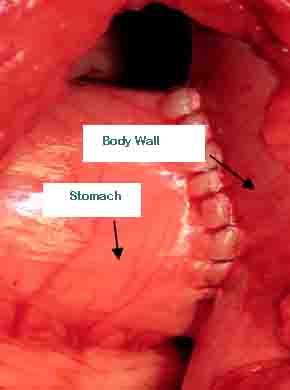 Photo of Incisional Dog Gastropexy,
Surgery to Tack Stomach to the Body Wall
Photo of Incisional Dog Gastropexy,
Surgery to Tack Stomach to the Body WallCost of Surgery
Emergency dog bloat surgery (gastropexy) will cost between $3,000 to $8,000. The cost depends on the length of required post-operative care.
Bloat Home Remedy Kit
If your dog lives a distance from a vet, then a home dog bloat emergency kit makes sense. The kit contains instructions and a tube that can be passed through the mouth into the dog's stomach. The tube will remove air and decompress the stomach until you can get to a Veterinarian.
Prevention
Approximately 2/3 of dogs will have a reoccurrence of bloat. To prevent a second occurrence, the following steps can be taken:
- Watch for signs and symptoms, such as any stomach distension
- Avoid strenuous exercise when the dog’s stomach is full. Wait
until 1 hour after eating.
- Do not allow the drinking of large quantities of water in one sitting
- Eliminate water drinking 1 hour after and before meals
- Eliminate foods from the diet with citric acid
- Do not feed high fat foods (fat is in the first 4 ingredients)
- Do not use a raised food dish
- Provide 3 meals a day instead of 1 (each meal is 1/3 the size of 1 meal), slow meal consumption
- Soak dry food in water prior to feeding the dog
- If you dog gulps food, slow the rate of eating by buying a dog
food bowl that has multiple small compartments, which slows down the
dog.
Free feeding can be a preventive if a puppy continues to graze as an adult. Puppies free-fed will usually eat small amounts through the day. If the dog remains a grazer of food as an adult then the risk of GDV is reduced.
Prophylactic Gastropexy
Treated dogs that do not have damage to the stomach (necrosis) have a 98% survival rate. Dogs that have gastric necrosis have a 66% survival rate.
Ask Our Vet A Question, We'll Answer It For Free:
Have A Question For Our Vet About A Dog Stomach Problem?
Do you have a question for our veterinarian about a dog stomach problem? Share it and we will answer it for free!
Please include your dog's age, breed, medical history and if possible, a picture of the condition.
We will do our best to get back to you quickly (it depends on how many questions we receive each day). If you do require an immediate response we suggest using this online dog veterinary service that is available now.
Brochures for Additional Information on Dog Bloat
Dog Bloat Quick Reference Guide
(PDF Download)
Author: Nebraska Humane Society
Bloat in Dogs Risks and Prevention
(PDF Download)
Author:
Sallie Mayer
